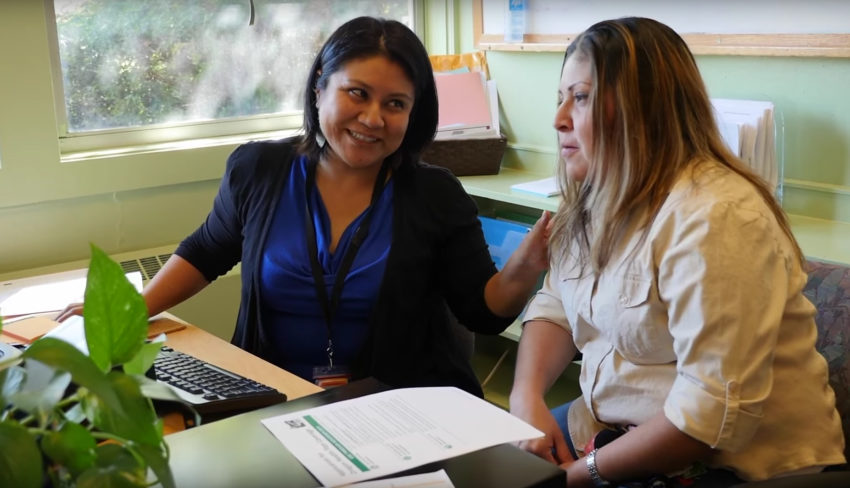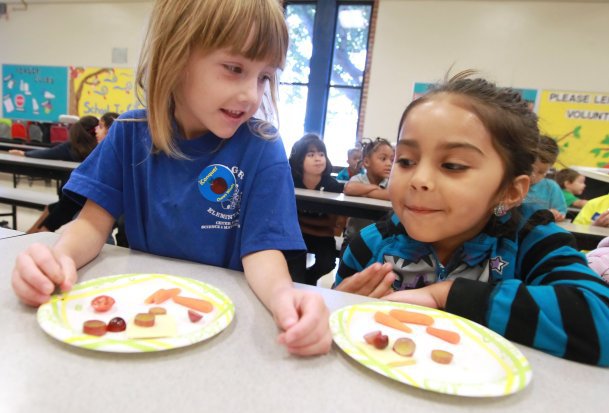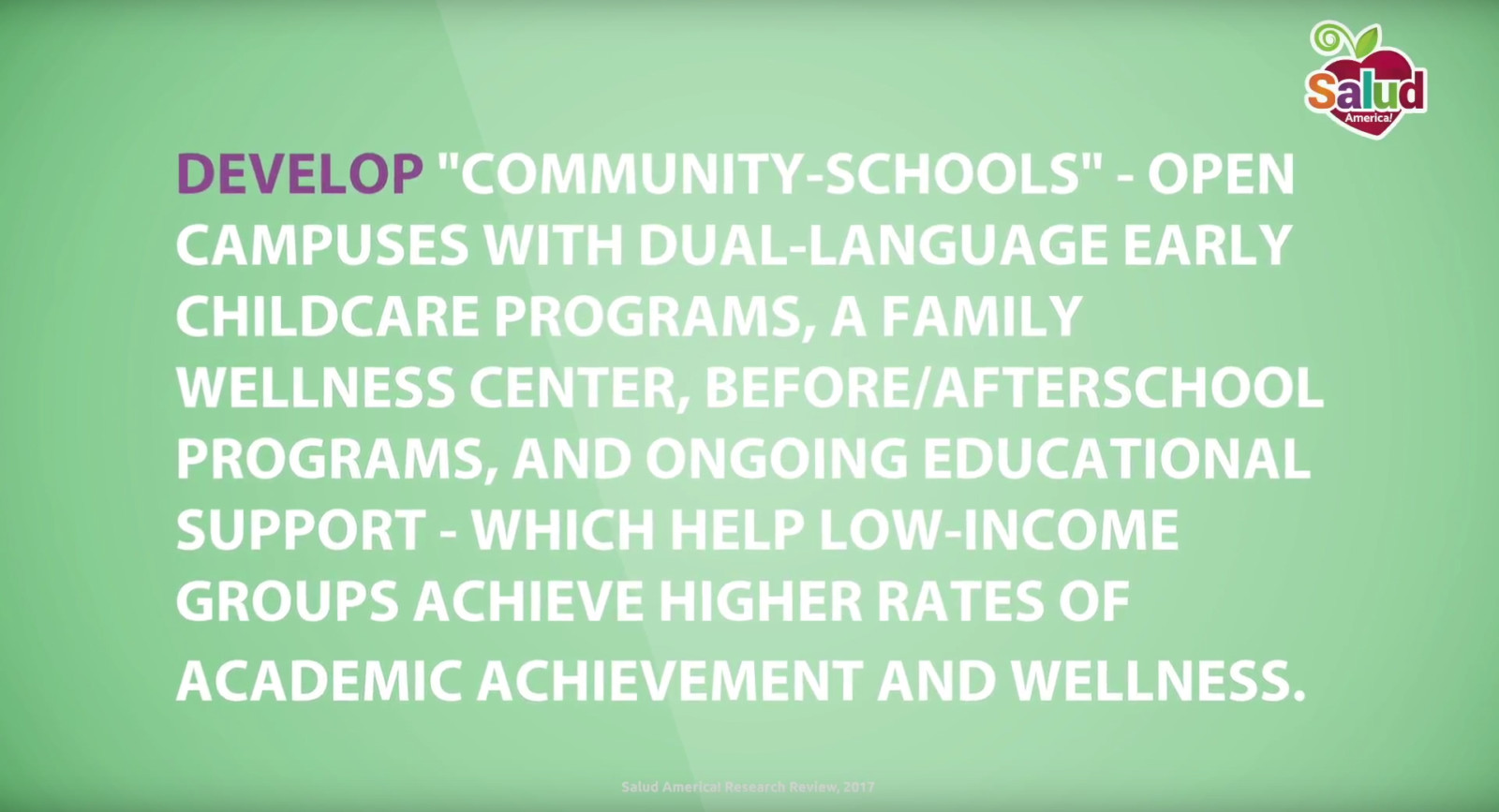
Share On Social!
This is part of our Building Support for Latino Families: A Research Review »
The Concept of Schools as Health Centers
Development of school-based health centers (SBHCs) that provide comprehensive care for students, and sometimes their families, has provided a solution for another important barrier to preventive and whole-self health care: access.21,116,127

Maintaining regular well visits and acute care without missing school or work is a challenge in low-income communities, making health care impossible for some students and families.127
The American Academy of Pediatrics has stated that a “medical home” is the ideal form of health care delivery for children and adolescents, and SBHCs strive to meet the AAP definition of a medical home: a system of care that is accessible, family centered, continuous, comprehensive, coordinated, compassionate, and culturally effective.128
By meeting the unmet physical and mental health needs of students and incorporating health care education in the school curriculum, SBHCs are able to promote preventive care and provide “well-care” services and education to the whole school population.
What is a ‘Community School’?
A community school is a nontraditional educational arrangement which includes student instructional hours within the structure of a community resource center.
Most include an on-site child care and early education center, wellness center, after-school programs, as well as a community resource center for families and neighborhood partners. In most cases, the school is open beyond traditional hours, to all members of the community, to be used as a meeting site, fitness center, medical office, and resource center, and results in the formation of local partnership building and stronger communities.
The “Framework for Better Learning Through Results-Focused Partnerships” states that a community school provides: 1) Health & Social Supports & Services, 2) Expanded Learning Opportunities, and 3) Family & Community Engagement.129
The community school strategy aims to promote student success by including parental involvement in children’s education, rich and engaging out-of-school experiences, student wellness, and family stability,125 all of which serve as family and social supports for optimal child development.
How a Community School Fits Latinos
Furthermore, several other tenets of the community school paradigm fit the needs of Latino communities perfectly: inclusion of an ECE center, extended service hours outside of a typical “work day,” structured before- and after- school education and year-round student programming, use of official locally-sourced “resource navigators” to connect with parents and students and guide them to needed services, and a full-service family wellness center that includes primary care, mental health care, and dental care (essentially serving as a “medical home”).
 Furthermore, by all being together at one site, there is continuity of services for both children and parents, allowing for improved monitoring and development of trusting community relationships.
Furthermore, by all being together at one site, there is continuity of services for both children and parents, allowing for improved monitoring and development of trusting community relationships.
Together, these elements align to provide the family and social supports needed in low-income Latino communities, as outlined throughout this paper.
Within this model, members of the community, including residents, business owners, elected officials, service providers, and community-based organizations, help plan the structure of services and are kept informed about the school and its programs.
In this way, every community school system is unique, catered to the specific needs of the local population.125
Early Head Start and Head Start programs can be brought in as ECE, or public pre-kindergarten programs are held on-site. Some community schools include support even earlier, by providing bilingual doula services and parent training program.
Following the “whole child” approach embraced by the community school strategy, support services continue throughout the school years, with many community high schools helping students get accepted to college and some may even line up support services for students to ensure college success.125 As a result, transitions are smooth, expectations are clear, and students succeed.
Research that Supports “Community Schools”
- Adolescents who spend after school hours (3-6pm) in constructive arts, sports, and community programs exhibit better academic outcomes and higher career aspirations than other teens,130 lower rates of juvenile crime and victimization,131 and lower rates of adolescent sexual activity, alcohol, and drug use than unsupervised teens.132,133
- Ongoing guidance and support throughout all grades in all domains of development (cognitive, social, emotional, physical, moral, and vocational) results in more productive adulthood134 and facilitates the individual’s ability to fill family, community and citizenship roles.135
- Fragmentation of resources for children and families limits program uptake and effectiveness; by contrast, sourcing or programs together at one site with the addition of local business partnerships results in high uptake and effectiveness.136
- The strongest intervention for reducing risk and promoting resilience among children and adolescents is integrating the delivery of quality education with health and social services; community schools have shown the highest rates of academic achievement in low-income populations, along with high rates of physical and emotional wellness.137
- Studies indicate that schools with gardens contribute to a more emotionally healthy place, providing academic, stress reduction, and social and emotional benefits.138
Many of the studies that support the community schools model support the forms of family and social support that is urgently needed in low-income Latino communities.
As the American sociologist and Coalition for Community Schools Founder Joy Dryfoos wrote, “the school is oriented toward the community, encouraging student learning through community service and service learning. A before and after-school learning component encourages students to build on their classroom experiences, expand their horizons, contribute to their communities, and have fun.”
“A family support center helps families with child rearing, employment, housing, immigration, and other services. Medical, dental, and mental health services are readily available. College faculty and students, business people, youth workers, neighbors, and family members come to support and bolster what schools are working hard to accomplish – ensuring young people’s academic, interpersonal, and career success.”139
This vision of a community school encompasses the goals outlined in this research review, making the development of community schools in Latino neighborhoods a policy priority.
What Does a Latino Community School Need?
In the case of community schools within Latino neighborhoods, the following resources should be included:
- Dual-language ECE with care from birth through prekindergarten for families with multiple children. This eases transport and parent involvement for busy working parents and caregivers.
- Family Resource Center providing: English language workshop for children and parents; assistance with immigration and citizenship paperwork; insurance assistance; and entitlement and resource navigation.
- Student & Family Wellness Center providing: Preventive medical care for students and family members, independent of immigration status or insurance coverage; early nutrition education for obesity prevention; on-site specialists for basic care of common comorbidities in Latino populations, including obesity and diabetes; obligatory counseling sessions for all students to remove the stigma of mental health care; and on-site trauma/violence/domestic abuse care for students and family
- University Partnership Center with: Internships and vocational training for students and parents; college preparation and application help for students; and adult education for parents.
How to Fund Community Schools
The Coalition for Community Schools140 outlines several federal and non-federal sources for funding, including competitive grants, Title I dollars, and specialized programs.
One major benefit of the community school model is the acquisition of non-education funds for services that support specific school functions, through such vehicles as Medicaid reimbursements and United Way allocations. Competitive government grants are available to fund burgeoning community school networks, due to the emerging evidence of their success at promoting healthier, more positive, more successful school environments and communities.125
Policymakers interested in securing funding to support community schools within Latino communities may be able to acquire funding through Latino-centered philanthropic institutions.
Taken together, the data presented in this review suggest interventions and policies that can best support children and families in Latino communities.
The data have suggested a need for 1) high-quality early childhood education (ECE) that engages Latino parents, ideally from birth through kindergarten, 2) two-generation programs that incorporate ECE but also focus on the needs of low-income Latino parents, with a particular emphasis on resources that enable employment in jobs with family-supporting wages, 3) comprehensive health care that focuses on prevention and wellness, not just “sick care,” for both the children and the parents, and 4) provision of these services in linguistically and culturally sensitive manners.
These needs dovetail closely with the goals of “community schools,” which are public schools that serve as community resource centers and family wellness centers, funded and sustained by public-private partnerships and community involvement.125,129
More from our Building Support for Latino Families: A Research Review »
- Introduction & Methods
- Key Research Finding: Latinos’ Big Healthcare Gaps
- Key Research Finding: Early Cognitive Development
- Key Research Finding: ECE Programs
- Key Research Finding: Disconnected Latino Parents
- Key Research Finding: Head Start Centers as Resource Hubs
- Key Research Finding: Promotores de Salud
- Key Research Finding: Latino Medical Homes
- Key Research Finding: Latino Community Schools (this section)
- Policy Implications
- Future Research Needs
References for this section »
21. Juckett, G. Caring for Latino Patients. Am. Fam. Physician 87, 48–54 (2013).
125. Lubell, E. Building Community Schools: A Guide for Action. Child. Aid Soc. (2011).
126. Merck, A. Health Navigator + School = Latino Parents Connected to Health Services. Salud America (2015). Available at: https://salud-america.org/health-navigators-in-elementary-schools-increase-latinos-access-to-health-care-services/. (Accessed: 29th September 2017)
127. Keeton, V., Soleimanpour, S. & Brindis, C. D. School-Based Health Centers in an Era of Health Care Reform: Building on History. Curr. Probl. Pediatr. Adolesc. Health Care 42, 132–156 (2012).
128. Flores, G. & Tomany-Korman, S. C. Racial and Ethnic Disparities in Medical and Dental Health, Access to Care, and Use of Services in US Children. PEDIATRICS 121, e286–e298 (2008).
129. American Academy of Pediatrics. Medical Home Initiatives for Children With Special Needs Project Advisory Committee. Pediatrics 110, 184–186 (2002).
130. Jacobson, R. & Blank, M. A frameworks for more and better learning through community school partnerships. (Institute for Educational Leadership, 2015).
131. McLaughlin, M. W. Community Counts: How Youth Organizations Matter for Youth Development. (2000).
132. Fight Crime: Invest in Kids. America’s Front Line against Crime: A School and Youth Violence Prevention Plan. (1998).
133. Gordon, E. W., Jean-Louis, B. & Obiora, N. Strengthening Families, Communities, and Schools to Support Children’s Development: Neighborhoods of Promise. (Routledge, 2017).
134. Richardson, J. L. et al. Substance Use Among Eighth-Grade Students Who Take Care of Themselves After School. Pediatrics 84, 556–566 (1989).
135. Eccles, J. The development of children ages 6 to 14. Future Child. Sch. Out 9, (1999).
136. A matter of time: risk and opportunity in the nonschool hours. (Carnegie Council on Adolescent Development, 1992).
137. Hodgkinson, H. L. The same client: the demographics of education and service delivery systems. (Institute for Educational Leadership, Center for Demographic Policy, 1989).
138. Hahn, K. Social and emotional health are important benefits of school gardens. MSU Extension Available at: http://msue.anr.msu.edu/news/social_and_emotional_health_are_important_benefits_of_school_gardens. (Accessed: 29th September 2017)
139. Dryfoos, J. Full-Service Schools: A Revolution in Health and Social Services for Children, Youth, and Families. (John Wiley & Sons, 1994).
140. The Coalition for Community Schools. Federal Funding. Institute for Educational Leadership Leading Across Boundaries Available at: http://www.communityschools.org/policy_advocacy/federal_funding.aspx. (Accessed: 29th September 2017)
Explore More:
Healthy Families & SchoolsBy The Numbers
142
Percent
Expected rise in Latino cancer cases in coming years



